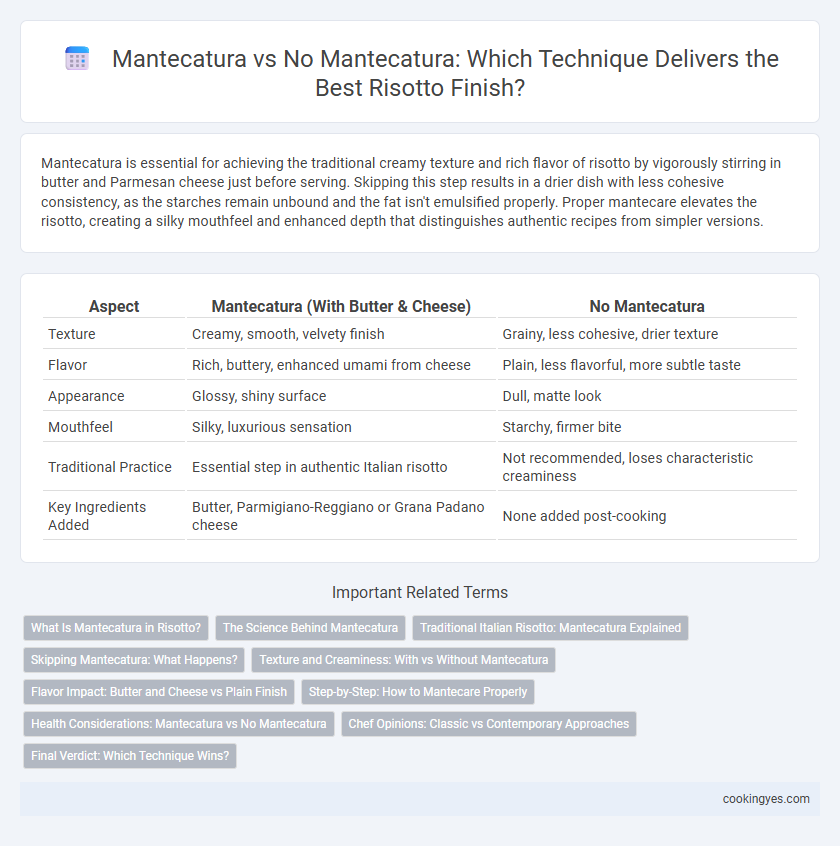Mantecatura is essential for achieving the traditional creamy texture and rich flavor of risotto by vigorously stirring in butter and Parmesan cheese just before serving. Skipping this step results in a drier dish with less cohesive consistency, as the starches remain unbound and the fat isn't emulsified properly. Proper mantecare elevates the risotto, creating a silky mouthfeel and enhanced depth that distinguishes authentic recipes from simpler versions.
Table of Comparison
| Aspect | Mantecatura (With Butter & Cheese) | No Mantecatura |
|---|---|---|
| Texture | Creamy, smooth, velvety finish | Grainy, less cohesive, drier texture |
| Flavor | Rich, buttery, enhanced umami from cheese | Plain, less flavorful, more subtle taste |
| Appearance | Glossy, shiny surface | Dull, matte look |
| Mouthfeel | Silky, luxurious sensation | Starchy, firmer bite |
| Traditional Practice | Essential step in authentic Italian risotto | Not recommended, loses characteristic creaminess |
| Key Ingredients Added | Butter, Parmigiano-Reggiano or Grana Padano cheese | None added post-cooking |
What Is Mantecatura in Risotto?
Mantecatura in risotto refers to the final step where cold butter and grated cheese are vigorously stirred into the hot rice to create a creamy, velvety texture. This technique enhances the risotto's flavor, richness, and smooth consistency, distinguishing it from risottos that skip mantecare and remain less cohesive and creamier. The key to perfect mantecatura lies in the temperature and timing, ensuring the butter emulsifies without melting completely, resulting in a luscious finish.
The Science Behind Mantecatura
Mantecatura is the crucial step in risotto preparation where adding cold butter and finely grated cheese off the heat emulsifies the starch released during cooking, creating a creamy, velvety texture. This process leverages the gelatinization of starch granules and the fat's ability to coat them, preventing clumping and promoting a smooth mouthfeel. Without mantecare, risotto risks being sticky or dry as the starches separate, compromising the signature creamy consistency essential to authentic risotto.
Traditional Italian Risotto: Mantecatura Explained
Traditional Italian risotto achieves its signature creamy texture through the process of manteccatura, which involves vigorously stirring butter and grated cheese into the risotto off the heat just before serving. Skipping manteccatura results in a less cohesive, drier dish lacking the velvety richness that defines authentic risotto. The emulsification of fat and starch during manteccatura enhances mouthfeel and flavor integration, making it essential for a genuine Italian risotto experience.
Skipping Mantecatura: What Happens?
Skipping mantecare in risotto results in a less creamy texture and a grainier mouthfeel, as the emulsification of butter and cheese with the starchy cooking liquid is essential for a smooth finish. Without mantecare, the risotto lacks the velvety consistency that binds the rice and flavors together, leading to a drier and less cohesive dish. This final stirring step not only enhances richness but also helps distribute heat evenly, ensuring optimal flavor integration.
Texture and Creaminess: With vs Without Mantecatura
Risotto finished with mantecare achieves a rich, velvety texture and enhanced creaminess due to the vigorous stirring and addition of butter and cheese at the end of cooking. Without mantecare, the risotto retains a drier consistency with more distinct, separate grains, resulting in a firmer bite and less cohesive creaminess. The mantecare process releases starches that create the characteristic smooth, luscious mouthfeel essential to traditional Italian risotto.
Flavor Impact: Butter and Cheese vs Plain Finish
Mantecatura, the process of vigorously stirring butter and cheese into risotto, creates a rich, creamy texture that enhances flavor depth and adds a velvety mouthfeel. Without mantecare, risotto tends to have a drier, less cohesive finish with a more pronounced rice texture but lacks the savory richness imparted by butter and Parmigiano-Reggiano. The butter and cheese blend in mantecare balances acidity and sweetness, elevating umami and making each bite more indulgent compared to a plain finish.
Step-by-Step: How to Mantecare Properly
Mantecare is the essential step of vigorously stirring risotto off heat while gradually adding cold butter and finely grated Parmigiano-Reggiano, resulting in a creamy, velvety texture that distinguishes authentic risotto from a dry or watery version. Without mantecare, the risotto grains remain separate and lack the luxurious cohesion that binds the dish, leading to a less rich mouthfeel and diminished flavor integration. Proper mantecare requires removing the pot from heat and folding in butter and cheese slowly, ensuring the starchy rice releases its natural creaminess and absorbs the added fat for an optimal consistency.
Health Considerations: Mantecatura vs No Mantecatura
Mantecatura, the process of vigorously stirring butter and cheese into risotto at the end, significantly enriches flavor and texture but adds saturated fats and calories, which may affect individuals monitoring heart health or weight. Skipping mantecare results in a lighter risotto with fewer added fats, preserving more of the original rice's nutritional profile and making it suitable for low-fat or calorie-conscious diets. Choosing between mantecare and no mantecare depends on balancing desired creaminess with specific dietary goals such as reduced fat intake or managing cholesterol levels.
Chef Opinions: Classic vs Contemporary Approaches
Chef opinions on risotto finishing differ significantly between classic and contemporary approaches, with many traditionalists emphasizing mantecare as essential for achieving the dish's signature creamy texture and rich flavor. Contemporary chefs sometimes forgo mantecare to highlight the individual grains of rice and introduce lighter, more textured variations that align with modern culinary trends. This divergence showcases the evolving balance between preserving time-honored techniques and embracing innovation in risotto preparation.
Final Verdict: Which Technique Wins?
Mantecatura creates a creamy, velvety texture by vigorously stirring in cold butter and cheese at the end of cooking, enhancing risotto's richness and mouthfeel. Without mantecare, the risotto tends to be less cohesive, with a drier and grainier consistency, lacking the signature smoothness. The final verdict favors mantecare for achieving the authentic, luxurious risotto experience prized in Italian cuisine.
Manttecatura vs no mantecare for risotto finish Infographic

 cookingyes.com
cookingyes.com